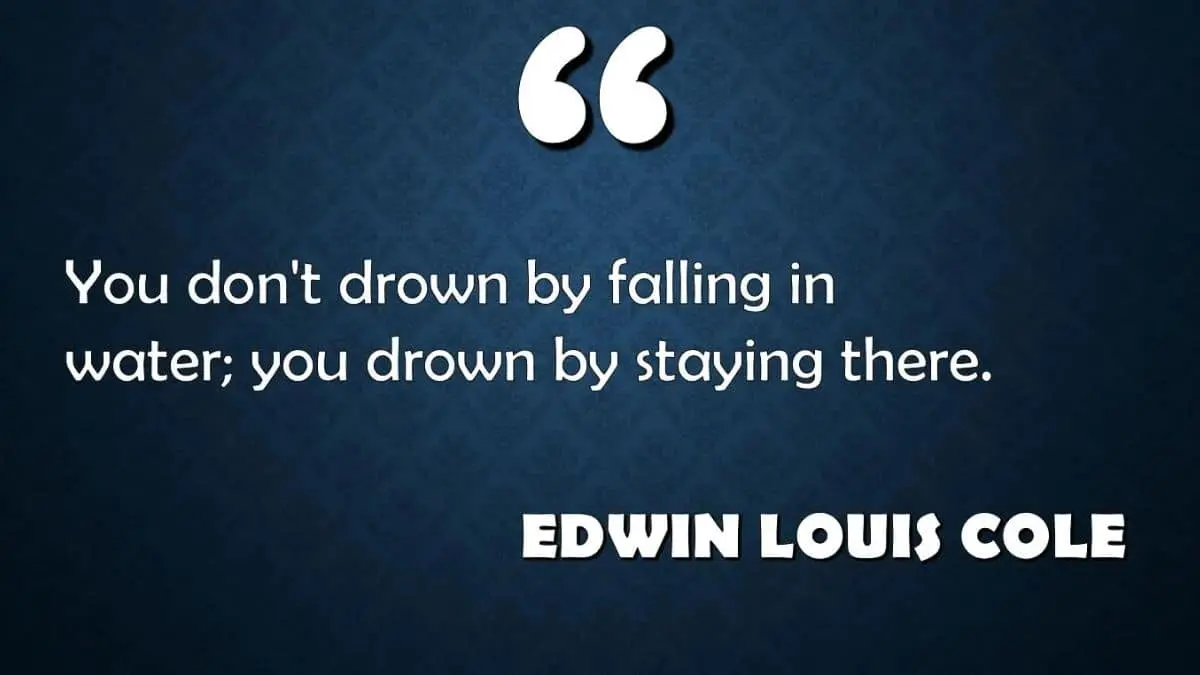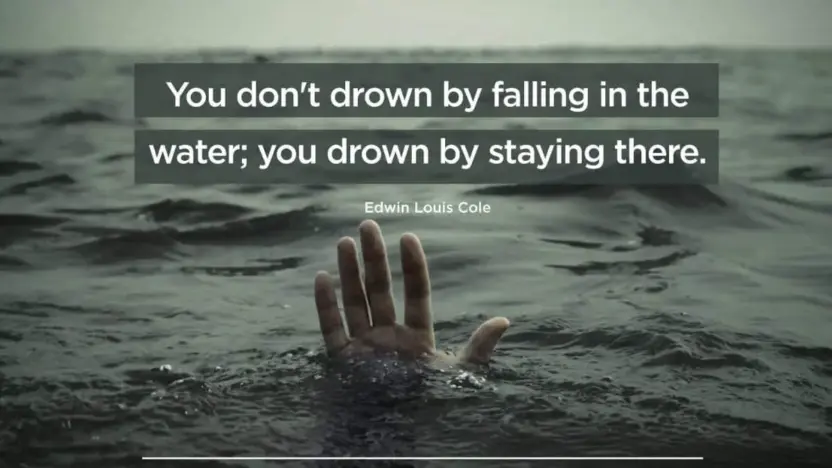You don’t drown by falling in the water; you drown by staying there.
Edwin Louis Cole
This profound statement encapsulates a powerful life lesson. It’s not about the fall into the water – the challenges and setbacks we face – but how we react to them that truly defines our journey. In this post, we’ll dive deep into understanding this quote, exploring its implications in various aspects of life, and how we can apply its wisdom to emerge stronger and more resilient.
The Inevitability of Falling
In the journey of life, falling is as inevitable as the tide that ebbs and flows. It’s a universal experience, a shared moment in the human condition that we all must face at various points in our lives. Whether it’s a minor stumble or a significant plunge, these falls come in many forms: the loss of a loved one, the collapse of a business venture, or a personal setback that shakes our very foundation. Understanding the nature and inevitability of these falls is crucial in learning how to rise again.
Understanding the Fall: A Psychological Perspective
The first step in dealing with a fall is understanding it. Psychological research shows that how we perceive our setbacks significantly impacts our ability to rise above them. A mindset that views challenges as opportunities for growth – a growth mindset – can be instrumental in transforming these situations from drowning experiences to learning opportunities.
The Dangers of Staying in the Water
The metaphor of staying in the water after falling in encapsulates the dangers of lingering too long in a state of failure, disappointment, or setback. It’s about becoming stagnant in our negative experiences, allowing them to engulf us, rather than striving to emerge from them. This section explores the risks associated with dwelling in our failures and the impact it can have on our mental, emotional, and even physical well-being.
Psychological Impact of Dwelling on Failures
When we stay in the water, we are essentially allowing our failures to define us. This can lead to a range of psychological issues, including chronic stress, anxiety, and depression. Prolonged focus on negative experiences can create a cycle of negative thinking, where one begins to view life through a lens of pessimism and defeat. This mindset can hinder personal growth, affect relationships, and even impact professional performance.
Rumination: The Enemy of Progress
Rumination, or the act of continuously thinking about the same thoughts, particularly negative ones, is a common response to failure. However, rumination is counterproductive; it traps individuals in a cycle of negativity, preventing them from moving forward. It’s like swimming in circles in the water, unable to find the shore. Studies have shown that rumination can exacerbate feelings of depression and anxiety and can even lead to a decline in problem-solving ability and creativity.
Physical Consequences of Stagnation
The dangers of staying in the water extend beyond mental health. Chronic stress and anxiety can have significant physical consequences, including increased risk of heart disease, weakened immune system, and other health issues. This physical decline can create a feedback loop, further impacting mental health and overall quality of life.
Social and Professional Impacts
Remaining fixated on failures can also have a detrimental effect on one’s social and professional life. In the professional realm, an inability to move past setbacks can stifle career growth and innovation. Socially, it can lead to strained relationships, as the negativity and lack of progress can be draining for both the individual and those around them.
The Paralysis of Inaction
One of the most significant dangers of staying in the water is the paralysis of inaction. When we are consumed by our setbacks, we often become immobilized, unable to make decisions or take steps towards improvement. This inaction can lead to missed opportunities and a sense of helplessness, further entrenching the individual in their current state.

Strategies to Swim Ashore: Overcoming Challenges
Swimming ashore after falling into the water of life’s challenges requires more than just the desire to escape our setbacks; it demands a combination of mindset, tools, and actions. This section provides practical strategies for overcoming challenges, enabling us to move from stagnation to progress, from dwelling in our failures to actively pursuing success and personal growth.
Adopting a Growth Mindset
The cornerstone of overcoming challenges is cultivating a growth mindset, a concept popularized by psychologist Carol Dweck. This mindset revolves around the belief that our abilities and intelligence can be developed through dedication and hard work. By adopting a growth mindset, we view failures not as evidence of unintelligence or inability, but as opportunities for learning and development. This perspective shift is crucial in transforming our approach to setbacks.
- Embrace Challenges: See challenges as opportunities to grow rather than insurmountable obstacles.
- Learn from Criticism: Use constructive criticism as a tool for improvement rather than a personal attack.
- Celebrate Effort: Recognize that effort and perseverance are key components of success.
Building Resilience
Resilience is our ability to bounce back from setbacks. It’s about developing a core of inner strength that helps us navigate through difficulties.
- Develop Emotional Intelligence: Understanding and managing our emotions can significantly aid in dealing with setbacks.
- Foster Strong Relationships: A robust support system provides encouragement and perspective during tough times.
- Practice Optimism: Maintaining a positive outlook enables us to approach challenges with hope and confidence.
Learning from Failure
Every failure has a lesson hidden within it. By analyzing our failures, we can gain insights that are critical for future success.
- Reflect Constructively: Instead of dwelling on the failure, focus on what can be learned from the experience.
- Adapt and Adjust: Use the insights gained to modify your approach or strategy.
- Set Realistic Goals: Setting achievable goals can provide direction and a sense of purpose.
The Power of Perspective
Changing our perspective towards setbacks can alter our response to them dramatically.
- Reframe the Situation: Instead of viewing a situation as a failure, see it as a setback that is a natural part of the journey towards success.
- Focus on the Controllable Elements: Concentrate on aspects of the situation that you can influence or change.
- Practice Gratitude: Focusing on what we are thankful for can shift our perspective from what we lack to what we have.
Taking Action: Moving Forward
Action is the final and most critical step in swimming ashore. Without action, all strategies remain theoretical.
- Create a Plan: Develop a step-by-step plan to move forward from your current situation.
- Take Small Steps: Start with small, manageable steps to build momentum.
- Stay Consistent: Consistency is key in making progress. Regularly review and adjust your plan as necessary.
Conclusion: The Journey Continues
As we conclude our exploration of the profound quote, “You don’t drown by falling in the water; you drown by staying there,” it’s important to recognize that the journey through life’s challenges is continuous and ever-evolving. This journey is not just about avoiding drowning in the face of adversity but learning how to swim through it with resilience, grace, and wisdom.
Also Read: Start where you are. Use what you have. Do what you can.



